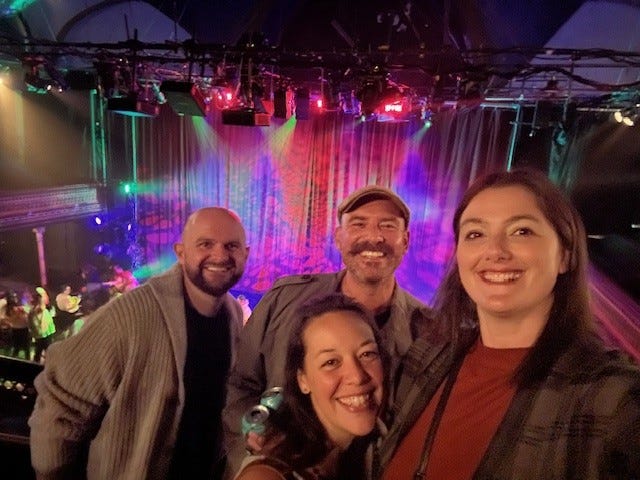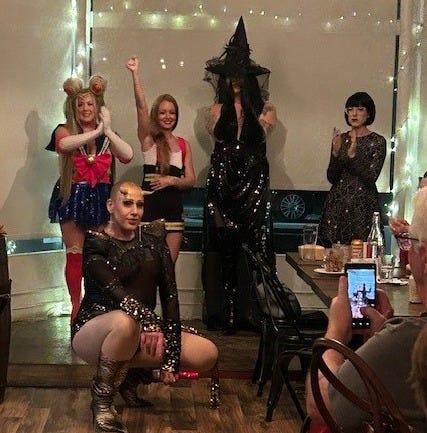From the Stage to the Heart: How Live Entertainment Connects and Transforms
And the therapeutic power of a whole lot of laughter

On Thanksgiving weekend, we saw “Evil Dead The Musical” in Toronto. If you asked me at various points leading up to the show, I might have called it, “Walking Dead” (zombies, not demons), “Night of the Living Dead” (also, zombies), or “Night of the Evil Dead” (not a show).
Needless to say, I did not plan this outing. A musical based on an 80’s horror movie was not on my bucket list. My husband loves slasher flicks though, so, when he made this plan with our friends and asked if I wanted to come, I said, “Sure!” A good horror-comedy does entertain me after all, and I was SO happy we went!
First, the show was excellent! It was funny. So funny, I laughed loudly and a lot! I even wondered at one point if the people in front of us were annoyed with my constant laughing. But I didn’t care.
I’m not a film expert, but I think without all the special effects, spine-tingling score, or dramatic camera angles, a horror quickly becomes comedic.
The acting was also fantastic. There’s something about a musical where everything feels a little over the top that makes it just so good.
My husband and our friends also loved it. All night after we were exclaiming, “That was so good!”
It’s somewhat ironic because I was not that excited about going. We were just back from our road trip, that was a vacation but not overly restful, and I had a super busy week at work coming up. My body was craving rest. A weekend on the couch reading and writing.
As it turned out, I also really needed to laugh. Like big belly laughs for three hours. Followed by really good, late-night Szechuan food with good people, and it was the perfect antidote to my stress. I even came home feeling rested.
What I loved most was that for three full hours, I didn’t think about anything else. I didn’t think about my upcoming council meeting, the many issues on the agenda, or the restaurant website updates I needed to do. It was such a total escape.
I had forgotten how live theatre has the power to do that. In the dark room, you are surrounded by people but at the same time, it feels like it’s just you and the show on stage. And when it’s really good, you forget everything else. Including that little device that usually takes so much of our attention.
This is the power of live theatre.
But it’s not only theatre that does this. Good art, in all its forms, has the effect of providing an escape. It also transforms something in us in a way that makes the world look a little different. Whether it’s live music, visual art, or performing arts, I’m sure we’ve all had experiences where our attention has been captivated in this way.

And it’s not an experience limited to big city venues. I see it every time we host a drag show or cabaret at the restaurant—these events bring joy and have formed a community of their own in our rural area.
They have served as an escape for me when I was stressed. The energy and talent of the performers have been the disruption I needed to break out of a melancholic state. Because let me assure you, nothing disrupts melancholy like the music, glamour, and laughter of five, loud drag queens.
But as transformative as these experiences are, they come with a cost. Art—whether it’s a big show or an intimate cabaret—isn't always accessible to everyone. The time, expense, and even location create hurdles that limit who can take part in these enriching moments.
There are the costs involved with tickets and accommodations, as well as the time required to participate in many arts activities. Three hours uninterrupted may be a herculean feat on its own, let alone to get away to take in a show. And then there is the exceptional talent. The drag I get to see is exceptional. I’m talking the best of the best.
That’s not always the case and it’s harder to escape when the performance is not great, and there are those out there. I recall a podcast from earlier this year that lamented the bleak future of live theatre and just how little “good” work is being created. It may have been based on the NYT article by Isaac Butler that sounded an alarm on the breakdown of the U.S. theatre industry. He writes:
“This smoldering crisis was exacerbated by the pandemic, a ruinous event that has closed theaters, broken the theatergoing habit for audiences and led to a calamitous increase in costs at a moment when they can least be absorbed. A collapse in the nonprofit sector doesn’t just mean fewer theaters and fewer shows across the country; it also means less ambitious work, fewer risks taken and smaller casts. The reverberations will be felt up and down the theatrical chain, and a new generation of talent will be neglected.”
This issue is not limited to south of the border. As arts funding and institutions face uncertain futures here in Canada, we’re left questioning their sustainability and even mistaking art for 'culture'. In a Canadaland episode this spring, Jesse Wente put it powerfully:
“Culture has always existed. It’s the colonial ideas and institutions which are breaking down.”
This comment stuck with me for weeks. Culture is far more than built structures and select activities, like festivals and events. Yet, how often do we think of culture, and art by extension, through this narrow lens?
Culture has always existed. It’s made up of some objects but also the values, beliefs, and traditions of a group of people. We are a country made up of many different groups of people, with many different cultures of their own, as well as shared values, beliefs, and activities we consider Canadian. All this in a place where people with their own cultures lived before us.
At the same time, it’s easy to overlook the culture of our rural communities and neglect the art that is woven into the fabric of everyday life. It may not always take the shape of grand performances or exhibits, but its impact is no less profound or important to our individual and collective well-being.
So, after what was perhaps the longest introduction ever, I’m looking forward to exploring examples and the value of rural art in the coming weeks. As creativity surfaces here in unexpected ways, I think this will be both fun to write and also an important topic.
I’d love to hear what art looks like in your town. What are you doing to foster and celebrate this art so it can continue to enrich our lives? What are the activities that shape the culture of your community and which ones provide an escape?




I love this newsletter Jen - and agree a live performance is healing, nurturing and fun ! It cannot be replicated by anything on screen -and truly does offer one an escape from the everyday ! Luckily in our part of rural Ontario culture is available in so many shapes and forms from community theatre to small galleries and art events . Our family was drawn to living here in part due to the abundance of artistic happenings and opportunities . Fortunately one can spark new initiatives and gather other creatives together if the idea surfaces - this I have found easier here than in larger urban centres . Of course this takes energy and often it’s folks like yourself that are already doing so much for community already that take on new initiatives and leadership . I love that your restaurant offers live drag shows ! You demonstrate that fun and ingenuity can exist in small rural towns !
More recently I have found the momentum to co lead a local urban sketchers group which offers free events monthly for sketchers of all abilities . There is so much potential isnt there?